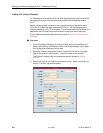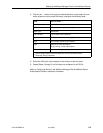
Setting Up NetScout Manager Plus for FrameSaver Devices
8-10
9123-A2-GB20-10
July 2000
Creating History Files
Up to 14 additional user history tables can be created in the FrameSaver unit for
each interface. An interface is a specific DLCI or the entire frame relay interface.
A table must be created for each DLCI or frame relay link to be monitored.
Additional user history tables are created using the command-line prompt in
NetScout Manager Plus to load a file that contains the OIDs (Object IDs) to be
monitored into the unit.
OpenLane provides several useful examples, including three files containing a
complete set of OIDs appropriate to the interface to be monitored: one for a
DLCI, one for a frame relay link, and one containing system-type OIDs. Any of
these files can be used as a template when creating customized history files
specific to the FrameSaver unit.
These files have a pdn*.udh (user-defined history) format and are found in the
OpenLane/netscout/userHistory directory. The userHistory files should be
moved to $NSHOME/usr so they can be used.
A separate *.udh file must be created and loaded for each DLCI or link that will be
monitored before a customized user history table can be loaded. Use a text editor
to create these *.udh files by:
H Copying one of the interface-specific files (DLCI or link) and editing it using
one of the examples provided as a guide.
H Copying one of the examples provided and editing the extensions to fit the
FrameSaver unit.
CAUTION:
Two user history table files are already configured and installed in the
unit, UserHistory1 and UserHistory2. These files must not be modified.
These two tables are used to keep SLV data for reports.
It is always a good idea to rediscover agents and their DLCIs before starting to be
sure your agent and DLCI lists are current. To rediscover agents and their DLCIs,
select the Learn button on the NetScout Manager Plus main window (the
FrameRelay and Admin radio buttons still selected).


















